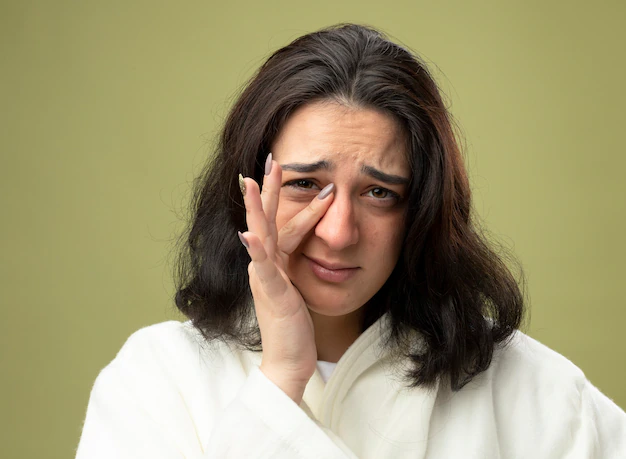This content is for informational and educational purposes only. Always consult a qualified healthcare provider.
Last Updated on June 18, 2024 by Grace Oluchi
📋 Table of Contents
What Is A Stye
A stye (also called a hordeolum) is a painful red bump on your eyelid egde. It is quite similar to an acne pimple. A stye forms when an oil producing gland in your eyelash follicle or eyelid skin becomes blocked and gets infected. This is caused by the bacteria staphylococcus
The staphylococcus bacteria lives normally and harmlessly on the skin, but they can get infected if the skin is damaged. Touching the snot in one’s nose and then rubbing the eye can move the staphylococcus bacteria to the eyelid.
Styes are very common and in many cases, you can manage a stye at home. However, some cases may require treatment by an eye care provider.
There Are Two Types Of Stye
1 . Internal Stye: Internal stye forms on either of your inner eyelids (facing your eyeball). An internal is usually caused by an infection in the inner eyelid gland that produces oils that help in keeping your eyelid moist.
2 . External Stye: These ones form on the outer part of either your upper or lower eyelid. External styes tend to be the one that happens to people. They are caused by an infection in your eyelash follicle.
Causes
A stye is caused by a bacterial infection in a person’s eyelid’s oil- producing glands. Some factors are :
- Touching your eyes with dirty hands
- Leaving makeup on your overnight
- Inserting contact lenses without them being disinfected
- Dandruff
- Diabetes
- Blepharitis
- Using expired or old cosmetics
- High levels of bad cholesterol
- Dirty water
- Dry skin
- Dirty pillow cases and sheets
- Have had stye before
- Hormonal changes
How Can I Prevent Stye
As common as a stye infection is, there are certain parts you can play to prevent it. Some ways you can prevent it are:
- Regular washing of your hands with soap and water or an alcohol – based hand sanitizer can help keep a stye infection from happening. It’s also good to keep your hands away from your eyes.
- Remove makeup before going to bed
- Avoid sharing eye makeup with anyone else Wash your face to remove dirt ( but not too much)
- Wash your hands before and after removing contact lenses
What Are The Symptoms?
The ways styes develop include:
- Tearing (the stye can irritate the eye causing it to water)
- A red lump on your eyelid that is similar to a boil or pimple.
- Swelling
What Remedies Can I Attempt?
Stye can be very painful and irritating. Though they can go on away, you can still perform certain things that can ease the pain and feel better much quickly. You can try the following things:
1 . Hot compresses: Hot compresses can help relieve pain and may also help to get rid of teg infection.
To do this, take a piece of material such as cotton balls, and put in hot water to heat it up (make sure it’s to a manageable temperature) and place gently on the eyelid for several minutes, until it cools. Then replace it with another compress. Do this several times a day for better results.
2 . Paracetamol: Taking paracetamol will help with the pain and possibly fever)
3 . Clean Eyelids: Gently wipe away eye discharge with a mild soapy solution gotten from potion of baby shampoo and some water. You can also use the eyelid wipes available in most drugstores.
4 . Antibiotic Ointments: Sometimes antibiotics may be needed and, occasionally, you may need oral antibiotics (taken by mouth)
Warning
Make sure you don’t do the following:
- Squeeze or try to pop it
- Wear makeup or contact lenses with a stye
- .Rub or touch eyelid
Should I Stay Indoors If I have Stye?
Styes aren’t considered contagious. You can still go to work or send your child to school if they have stye. Only that it can be very inconveniencing and can affect performance so it’s better to treat yourself and get proper rest when you have a stye infection.
Will A Stye Go Away On It’s Own?
A stye will usually go away by itself. But if it doesn’t go away on it’s own, you may need to visit an eye care provider for it to be drained. Your eye care provider may also prescribe antibiotics to reduce the infection.
How Long Will It Last?
Styes don’t usually stay for too long. A stye can last one to two weeks. But in most cases, when it overstays it’s welcome (not that it was even welcome in the first place!) be sure to to visit an eye care provider for assistance.
The Bottom Line
Styes are pretty common, though they can be very painful, they aren’t a cause for concern. Having a stye is usually manageable with a good eyelid hygiene, and in most cases the stye will go away on its own.
Although, you should contact your doctor if it doesn’t seem to improve and the redness and swelling involves the entire eyelid and extends into your cheeks or other parts of your face.

